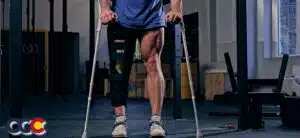Football fans may often hear about torn ACLs. But the PCL (which stands for posterior cruciate ligament) is often less understood. PCL tears aren’t all that common. Compromising less than 20%of knee ligament injuries, a PCL injury can be painful and debilitating and can cause some serious issues with your knee, such as osteoarthritis, if not addressed adequately. PCL injuries often go undiagnosed or are initially diagnosed as knee sprains. This can lead to complications and discomfort, also. That’s why it’s important to see an orthopedic specialist when there is an issue with the knee. Highly-trained specialists like those at Advanced Orthopedics in Denver, Parker, and Aurora, Colorado. If it is a PCL tear, they’ll know, and they’ll know how to treat it to get you up and going again. Wherever you want to go.
PCL OVERVIEW
Posterior cruciate ligament (PCL) injuries to the knee are acute and often happen without warning. What makes a PCL less common? The PCL—posterior cruciate ligament– is twice as thick as the ACL—anterior cruciate ligament. This results in fewer injuries than the ACL due to its stronger nature. Although it is larger and stronger than the ACL, the PCL can be torn. A PCL injury (which may also be called hyperextended knee) is a partial or complete tearing or stretching of any part of the posterior cruciate ligament. PCL injuries can happen to anyone, but they’re especially common among skiers and athletes who play baseball, football, or soccer. They can even happen to children participating in high-speed sports such as basketball.
ABOUT THE KNEE
The knee is one of the largest and most complex joints in the body. As such, it is very vulnerable to injury. The knee is a hinge joint, allowing one to sit, squat, or jump. It is designed to fulfill several functions: support the body in an upright position without the need for muscles to work, help lower and raise the body, act as a shock absorber and provide balance. The posterior cruciate ligament (PCL) and the anterior cruciate ligament (ACL) are two tough bands of fibrous tissue that connect the thighbone (femur) and the large bone of the lower leg (tibia) at the knee joint. Together, the ACL and PCL bridge the inside of the knee joint, forming an “X” pattern that stabilizes the knee against front-to-back and back-to-front forces. In particular, the PCL prevents the lower leg from slipping too far back in relation to the upper leg, especially when the knee is flexed (bent).
PCL INJURY
When the PCL is sprained or torn, it’s called a posterior cruciate ligament injury. Injuries that tear the PCL often damage some of the other ligaments or cartilage in the knee, and can injure, nerves and blood vessels as well. In some cases, the ligament can also break loose a piece of the underlying bone. An injury to the PCL can cause mild to severe damage. Doctors classify PCL injuries into these groups:
- Grade I: The PCL has a partial tear.
- Grade II: The ligament is partially torn and is looser than in Grade I.
- Grade III: The ligament is completely torn, and the knee becomes unstable.
- Grade IV: The PCL is damaged along with another ligament in the knee.
PCL problems can be acute or chronic. Acute PCL problems are due to a sudden injury. Chronic PCL problems involve an injury that develops over time.
PCL TEAR RISK FACTORS
The most common mechanism of injury of the PCL is the so-called “dashboard injury.” This occurs when the knee is bent and an object forcefully strikes the shin backward. It is called a “dashboard injury” because this can be seen in car collisions when the shin forcefully strikes the dashboard. The other common mechanism of injury is a sports injury when an athlete falls on the front of their knee. In this injury, the knee is hyper-flexed (bent all the way back), with the foot held pointing downwards. These types of injuries stress the PCL, and if the force is high enough, a PCL tear can be the result. PCL tears which can occur in sports or non-athletes:
- A person lands on a bent knee, such as during a fall or misstep.
- Landing directly on the front of the shinbone, such as when a dancer comes down from a fall and leaps.
- A person makes cutting or pivoting maneuvers.
- A sudden change of direction or speed.
- Turning abruptly.
- Twisting the knee suddenly and forcefully when the feet are on the ground.
- Overextending the knee.
- Doing manual labor. Certain jobs, such as construction and other jobs that require regularly squatting and lifting heavy objects, increase the risk of a PCL tear.
- Age – PCL tears are most commonly seen in 18 to 44 years olds. However, older adults are more prone to ligament injury due to general wear and tear.
SYMPTOMS
After a PCL injury, people often think they only have a minor knee problem. When patients have instability after a PCL injury, they usually state that they can’t “trust” their knee or that it feels like the knee may give out. They may try to go on with their usual activities. However, symptoms that can develop include:
- Sharp or dull pain around the back of the knee can occur immediately or develop in the hours or days after the injury.
- Swelling that results from bleeding around the torn ligament, which typically occurs within 2 to 3 hours of the injury.
- Stiffness, such as having trouble bending the knee, resulting in a limp or difficulty going up or down stairs.
- Difficulty bearing weight where the injured knee may be difficult or painful to stand or walk on.
- The back of the knee may be warm to the touch due to bleeding within the knee joint.
- Tenderness around the knee joint, particularly the back of the knee, may be sensitive even to the touch.
- In more severe PCL injuries, people may report the feeling of tingling or numbness around the knee joint.
NON-SURGICAL TREATMENTS
For the initial treatment of a PCL injury, the approach known as PRICE may be helpful. This includes:
- Protecting the knee from further injury
- Resting the knee
- Icing the knee for short periods with cold packs
- Compressing the knee gently, such as with an elastic bandage
- Elevating the knee
NSAIDs (non-steroidal anti-inflammatory drugs) like aspirin, ibuprofen, or naproxen may help reduce pain and swelling. Bracing or crutches may be recommended. Some people need to go through physical therapy after a PCL injury. The physical therapist (PT) will give you specific exercises to do. They’ll help strengthen the leg muscles around the knee and bring a full range of motion back to the knee joint.
WHEN IS SURGERY INDICATED?
Generally, surgery is only recommended for those with grade III PCL tears, multiple ligament injuries (such as a PCL and ACL tear), and knee instability that has not responded to nonsurgical treatment. Depending on the severity of the tear, there are multiple surgical options available to the surgeon. A good surgeon will discuss all these options in detail to determine what will have the best outcome.
GETTING THE RIGHT DIAGNOSIS
PCL tears are often difficult to identify and evaluate because this ligament is located deep inside the knee joint and is often accompanied by injuries to other knee structures. So, a differential diagnosis is essential. The highly-trained and accomplished doctors at Advanced Orthopedics in Denver, Parker, and Aurora, Colorado, have extensive experience diagnosing and treating PCL tears. A major factor in making the diagnosis of a PCL tear is by knowing how the injury happened. Knowing the story of the injury (for example, the position of the leg and the action taking place) will help make the diagnosis. Specific maneuvers can test the function of the PCL. If necessary, additional tests and imaging may be ordered. X-rays can provide information about a PCL injury. They can detect pieces of bone that may have broken loose from the injury. Magnetic resonance imaging (MRI) is a common way to create images of a PCL tear. An MRI can find the exact location of a tear. With chronic PCL injuries, a bone scan may be needed to look for bone damage. Whatever it takes, the doctors at Advanced Orthopedics take the time to get you back on the path to pain-free wellness.

















